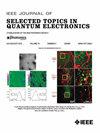基于建模的单光子雪崩二极管优化:面向室温下工作的集成量子光子器件
IF 5.1
2区 工程技术
Q1 ENGINEERING, ELECTRICAL & ELECTRONIC
IEEE Journal of Selected Topics in Quantum Electronics
Pub Date : 2025-03-18
DOI:10.1109/JSTQE.2025.3552673
引用次数: 0
摘要
单光子雪崩二极管(SPAD)正在成为超导纳米线单光子探测器(SNSPD)的一种经济实用的替代品,尤其适用于集成量子光子学。虽然 SNSPD 具有快速响应时间和高探测效率等卓越性能,但其对低温冷却系统的依赖导致其成本和功耗较高,且对便携式设备的适用性有限。相比之下,SPAD 可在室温下工作,无需笨重的冷却系统,大大降低了总体成本。然而,与 SNSPD 相比,SPAD 的性能亟待进一步优化。本文通过精确的 SPAD 器件建模和 TCAD 仿真,对 SPAD 防护环 (GR) 结构进行了优化,旨在提高其在集成量子光子学应用中的适用性。结果表明,经过 GR 优化的 SPAD 可以降低内部串联电阻,扩大雪崩倍增区域。因此,雪崩倍增区域扩大了约 20%,波长为 425 nm 的峰值光子探测概率提高了 48%。实现这一改进的同时,还能在 3 V 的过量偏置电压下保持 3.9 cps/μm2 的低暗计数率。此外,串联电阻的减小还提高了电流增益和回转速率,从而大大降低了定时抖动。本文章由计算机程序翻译,如有差异,请以英文原文为准。
Modeling-Based Optimization of a Single-Photon Avalanche Diode: Towards Integrated Quantum Photonics Devices Operating at Room-Temperature
Single-photon avalanche diodes (SPADs) are emerging as a cost-effective and practical alternative to superconducting nanowire single-photon detectors (SNSPDs), especially for integrated quantum photonics. While SNSPDs exhibit excellent performance such as fast response time and high detection efficiency, their reliance on a cryogenic cooling system results in high cost and power consumption as well as limited suitability for portable devices. In contrast, SPADs can operate at room temperature, eliminating the need for a bulky cooling system and significantly reducing the overall cost. Compared to SNSPDs, however, further optimization of SPAD performance is highly required. In this paper, the SPAD guard-ring (GR) structure is optimized with accurate SPAD device modeling and TCAD simulation, aiming to enhance their suitability for integrated quantum photonics applications. It is demonstrated that the GR-optimized SPAD can reduce internal series resistance and extend its avalanche multiplication region. As a result, the avalanche multiplication region is expanded by approximately 20%, and the peak photon detection probability at a wavelength of 425 nm is increased by 48% . This improvement is achieved while maintaining a low dark count rate of 3.9 cps/μm2 at an excess bias voltage of 3 V. Additionally, the reduced series resistance enables an increase in current gain and a faster slew rate, which results in much lower timing jitter.
求助全文
通过发布文献求助,成功后即可免费获取论文全文。
去求助
来源期刊

IEEE Journal of Selected Topics in Quantum Electronics
工程技术-工程:电子与电气
CiteScore
10.60
自引率
2.00%
发文量
212
审稿时长
3 months
期刊介绍:
Papers published in the IEEE Journal of Selected Topics in Quantum Electronics fall within the broad field of science and technology of quantum electronics of a device, subsystem, or system-oriented nature. Each issue is devoted to a specific topic within this broad spectrum. Announcements of the topical areas planned for future issues, along with deadlines for receipt of manuscripts, are published in this Journal and in the IEEE Journal of Quantum Electronics. Generally, the scope of manuscripts appropriate to this Journal is the same as that for the IEEE Journal of Quantum Electronics. Manuscripts are published that report original theoretical and/or experimental research results that advance the scientific and technological base of quantum electronics devices, systems, or applications. The Journal is dedicated toward publishing research results that advance the state of the art or add to the understanding of the generation, amplification, modulation, detection, waveguiding, or propagation characteristics of coherent electromagnetic radiation having sub-millimeter and shorter wavelengths. In order to be suitable for publication in this Journal, the content of manuscripts concerned with subject-related research must have a potential impact on advancing the technological base of quantum electronic devices, systems, and/or applications. Potential authors of subject-related research have the responsibility of pointing out this potential impact. System-oriented manuscripts must be concerned with systems that perform a function previously unavailable or that outperform previously established systems that did not use quantum electronic components or concepts. Tutorial and review papers are by invitation only.
 求助内容:
求助内容: 应助结果提醒方式:
应助结果提醒方式:


